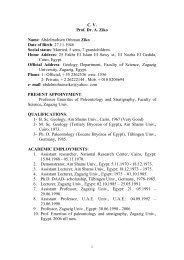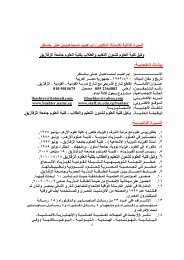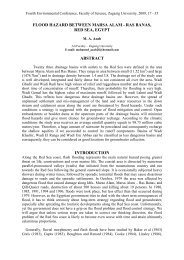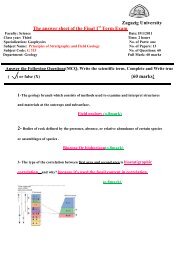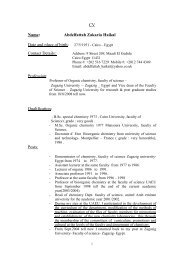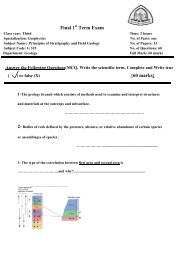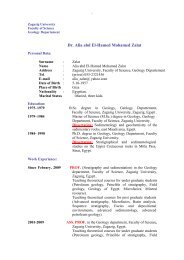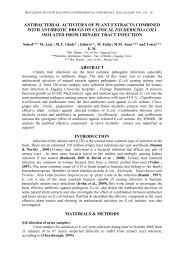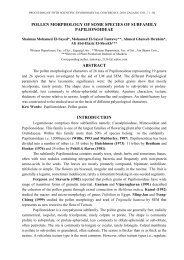prevalence of toxigenic bacteria in some egyptian food abstract ...
prevalence of toxigenic bacteria in some egyptian food abstract ...
prevalence of toxigenic bacteria in some egyptian food abstract ...
You also want an ePaper? Increase the reach of your titles
YUMPU automatically turns print PDFs into web optimized ePapers that Google loves.
122PREVALENCE OF TOXIGENIC BACTERIA IN SOME EGYPTIAN FOODLund, T. and Granum, P.E. (1997). Comparison <strong>of</strong> biological effect <strong>of</strong> the two differententerobtox<strong>in</strong> complexes isolated from three different stra<strong>in</strong>s <strong>of</strong> Bacilus cereus.Microbiology, 143:3329-3336.Mahler, H.; Pasi, A.; Kramer, J.M.; Schulte, P.; Scog<strong>in</strong>g, A.C.; Bar, W. andKrahenbuhl, S. (1997). Fulm<strong>in</strong>ant liver failure <strong>in</strong> association with emetic tox<strong>in</strong><strong>of</strong> Bacillus cerus. New England Journal <strong>of</strong> Medic<strong>in</strong>e, 336: 1142-1148.Mart<strong>in</strong>, M.C.; Fueyo, J.M.; Gonzalez-Hevia, M.A. and Mendoza, M.C. (2004). Geneticprocedures for identification <strong>of</strong> entero<strong>toxigenic</strong> stra<strong>in</strong>s <strong>of</strong> Staphylococcus aureusfrom three <strong>food</strong> poison<strong>in</strong>g outbreaks. International Journal <strong>of</strong> Food Microbiology.94( 3):279-286.Matsunaga, T., S. Kamata, N. Kakiichi, and A. Uccida. (1993). Characteristics <strong>of</strong>Staphylococcus aureus isolated from peracute, acute and chronic bov<strong>in</strong>e mastitis.J. Vet. Med. Sci. 55:297–300.McKillip, J.L. (2000): Prevalence and expression <strong>of</strong> enterotox<strong>in</strong>s <strong>in</strong> B. cereus and other B.spp., a literature review. Antonie van Leeuwenhoek 77, 393–399.McLauchl<strong>in</strong>, J.; Narayanan, G. L.; Mithani, V. and O’Neill, G. (2000). The detection <strong>of</strong>enterotox<strong>in</strong>s and toxic shock syndrome tox<strong>in</strong> genes <strong>in</strong> Staphylococcus aureus bypolymerase cha<strong>in</strong> reaction. J. Food Prot. 63(4):479–488.Miethke, T., C. Wahl, K. Heeg, B. Echtenacher, P. H. Krammer, and H. Wagner. (1992).T cell-mediated lethal shock triggered <strong>in</strong> mice by the superantigen staphylococcalenterotox<strong>in</strong> B: critical role <strong>of</strong> tumor necrosis factor. J. Exp. Med. 175:91–98.Misra, A.K. and Kuila, R.K. (1992). Use <strong>of</strong> Bifidobacterium bifidum <strong>in</strong> the manufacture <strong>of</strong>bifidus milk and its anti<strong>bacteria</strong>l activity. Lait,72(2): 213-220Ngamwongsatit, P.; Busari, W.; Pianariyanon, P.; Pulsrikarn, C.; Ohba, M.; Assavanig,A and Panbangred, W. (2008). Broad distribution <strong>of</strong> entertox<strong>in</strong> genes (hblCDA,nheABC, cytK, and entFM) among Bacillus thur<strong>in</strong>giensis and Bacillus cereus asshown by novel primers. International journal <strong>of</strong> <strong>food</strong> microbiology. 121:352-356.Olsen, J. E. (2000). DNA-based methods for detection <strong>of</strong> <strong>food</strong>-borne <strong>bacteria</strong>l pathogens.Food research <strong>in</strong>ternational. 33 (3-4):257-266.Olsen, J. E.; Aabo, S.; Rasmussen, O. F. and Rossen, L. (1995). Oligo-nucleotide probesspecific for the genus Salmonella and for S. typhimurium. Letters <strong>in</strong> AppliedMicrobiology. 20:160-166.Ombui, J.N.; Gitahi, N. and Gicheru, M. (2008). Direct detection <strong>of</strong> Bacillus cereusenterotox<strong>in</strong> genes <strong>in</strong> <strong>food</strong> by multiplex polymerase cha<strong>in</strong> reaction. InternationalJournal <strong>of</strong> Integrative Biology, 2(3):172.Oxoid Manual (1990). Culture media, <strong>in</strong>clud<strong>in</strong>g <strong>in</strong> gradients and other laboratory services.P<strong>in</strong>to, B; Chenoll, E. and Aznar, R. (2005). Identification and typ<strong>in</strong>g <strong>of</strong> <strong>food</strong> borneStaphylococcus aureus by PCR-based techniques. Syst. Appl.microbial. 37:4012–4019.Re<strong>in</strong>heimer, J.A.; Demkow, M.R.; Canditi, M.C. Austr, B. (1990). J.Dairy Technol., 45:5-9.Rhodehamel, E.J. and Harmon, S.M. (2001). Bacteriological Analytical Manual Onl<strong>in</strong>e.Chapter 14, Bacillus cereus. U.S. FDA, Center for Food Safety & AppliedNutrition.Schneider, K.R.; Parish, M.E.; Goodrich, R.M. and Cook<strong>in</strong>gham, T. (2004). Prevent<strong>in</strong>g<strong>food</strong> borne illness: Bacillus cereus and Bacillus anthracis. University <strong>of</strong> Florida,IFAS Extension. FSHNO04-05.http://edis.ifas.ufl.edu.Schoeni, J.L. and Wong, A.C.L. (2005). B. cereus <strong>food</strong> poison<strong>in</strong>g and its tox<strong>in</strong>s. J. FoodProt. 68, 636–648.



